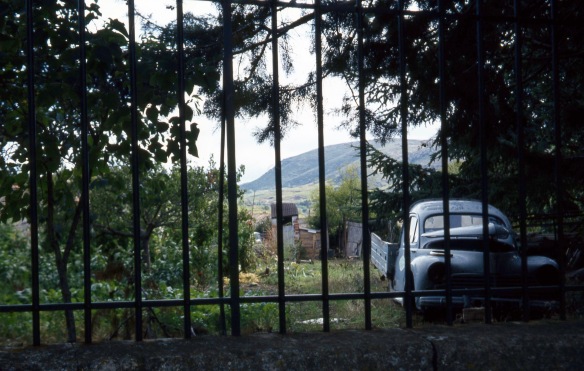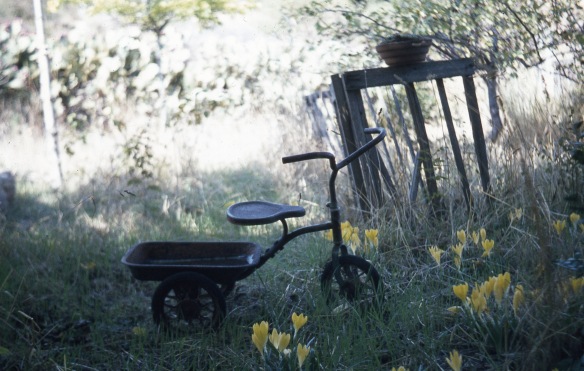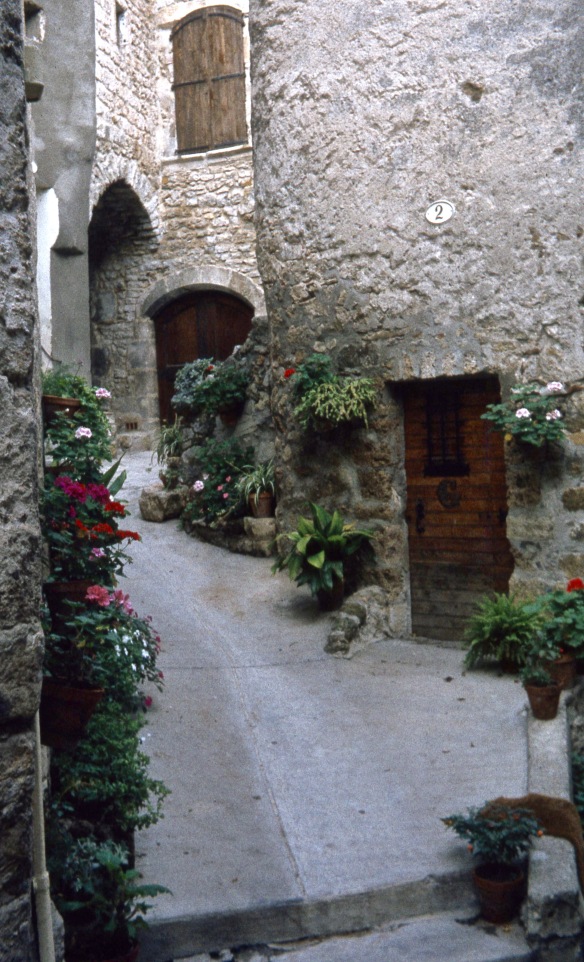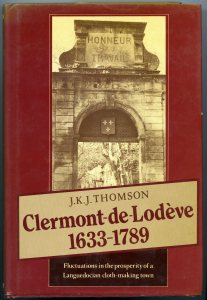Today we completed the weeding of the rose garden, and Jackie cleared out the potting shed, to which she adapted a set of shelves to fit.
This afternoon, I scanned a batch of colour slides from a French holiday in September and October 1981. We shared a house in Cabrieres, Languedoc with Jessica’s friend, Sue Sproston. The house belonged to a colleague of Sue’s who was in the process of renovating it, but hadn’t been too bothered about fixing potential leaks in the roof. Trust us to experience the worst thunderstorm locals could remember.



Here, Jessica and Sam see me off on a trip for the obligatory croissants from the boulangerie.

I found the local gardens fascinating. Some were carefully tended;


others seemed to be spaces to park trucks or trikes.


Cacti were in abundance. It seemed to me that, if the barbed wire had been designed to deter inquisitive fingers, it was probably somewhat superfluous.

Here Sue joins Jessica and Sam in investigating the local lake.

It was clearly the time of the vendanges, or the grape harvest.


We drove around the area and visited a number of villages, like the beautifully kept St Guilhem, and the almost abandoned Villeneuvette, where Sam sloshed in the fountain, a little less elaborate than the one in the grapes picture.
Wikipedia, currently has this to say about Colbert’s social and economic experiment:
‘Villeneuvette is a commune in the Hérault department in the Languedoc-Roussillon region in southern France.
It lies close to the town of Clermont l’Hérault.
Villeneuvette is a small village made up of a group of buildings initially erected in the 17th century to create a royal clothmaking factory and provide accommodation for its workers. Apart from a hotel and restaurant, the buildings are now restricted to residential use, many for holiday purposes.
Creation of Villeneuvette was promoted in 1677 by Jean-Baptiste Colbert the noted finance minister of King Louis XIV. It was one of his many initiatives to develop France’s industrial base. Power for the factory was hydraulic with water supplied via different water courses from existing basins. The factory was privately owned and produced cloth for the king including uniforms for his armies. The factory was in existence until 1955.
Since 1995 the village has been classified as a “Zone de Protection du Patrimoine et du Paysage” recognising the originality and importance of its heritage.
The original inscription above the gateway was “MANUFACTURE ROYALE” but was later rather crudely changed by the Republic to “HONNEUR AU TRAVAIL” – Honour in work.’
When we stumbled across the commune most dwellings were unoccupied, except for a few people who, to us, appeared to be squatters. We were able to amble around and marvel at the higgledy-piggledy nature of the accommodation, often with one family’s upper rooms above those of the residents below.
In 1982, J.K.J. Thomson published ‘Clermont-de-Lodeve 1633-1789’. Since it contains an erudite history of Villeneuvette, I had to buy it. It was, in fact, far too academic for my taste, but I did struggle through it. Interestingly, the book jacket shows the changed inscription mentioned above.

I was, perhaps fifteen years later, rather pleased I had, when one of my consutatiion clients told me that a couple of her friends had bought one of the residences which were now being sold on the open market. I was able to describe what we had seen, and to hand over the book. I didn’t expect to see it again, but, it was eventually returned to me by the wife, who happened to be a committee member of another agency client. Even then, before we were all overtaken by the Web, it was a small world.
This evening we dined on Jackie’s delicious lamb jalfrezi, savoury rice stuffed with goodies, and vegetable samosas; followed by apple strudel. We both drank Kingfisher.

It looks like such a charming area. Thank you for the history. Early industrial history is so interesting, and it’s amazing that the factory stayed in existence until 1955.
Thanks, Merril. It is a lovely place
Kind of place you could learn to paint. I’m not famailiar with amb jalfrezi
Dammit! You had me checking I hadn’t made a typo 🙂
A lovely little tour and history, Derrick and oooh, those grapes!
Thank you, Cynthia
Thanks for the tour, a lovely place for sure!
Thanks, Lynn
That was a lovely place to go,beautifull
Thanks, Janet
We know that area quite well although we haven’t been for a few years now. I remember walking around St Guihelm in searing heat. It was dead quiet and we were desperate for ice! There was a pottery shop near a small car park, I think. We found ice lollies eventually!
You have a better memory of St Guihelm than I do, Jenny. Thanks
Good photograph of Jessica and Sam. Did you eat the prickly pears? I wonder if there were plants to make dye around the cloth factory? Wine grapes can be good table grapes too.
Thanks, Mary. That is a fascinating thought about the prickly pears
Beautiful photos! Loved this post.
Thanks, Leslie
A now deceased Italian relative loved to talk of the importance of his village well. Young girls would deliberately throw away the last of the household water so they could genuinely tell their mothers they needed to fetch more. Waiting at the well, of course, were the young men of the village, including him.
An excellent source, Gwen. Thanks
Love this Derrick! Thank you for sharing with me/us 😍
Thanks, Val
That little Sam sure is a cutie! Oh wow, the first shot of St Guilhem is magnificent, Derrick.
Thank you, Jill
What a marvelous walk through memory lane. You have always had an eye for catching significant details and composing beautiful photographs. Thanks for sharing this lovely piece of memoirs. I always found the smaller French villages to be quite fascinating and Languedoc department has a wonderful charm about it.
Many thanks, Geetha
Welcome Derrick
All houses should have shutters like in those first photos!
I agree, Bruce. Thanks
I like how you think, Derrick 🙂 “obligatory croissants”
A beautiful and quietly place to visit and maybe to live. I like the path in the beautifully kept St Guilhem.
Thank you, Monica
😀
It looks a really beautiful place. I wonder if it has kept that beauty down the years?
Well, it has certainly been gentrified, but I haven’t been there since
What a magical place. That photo of Sam in the fountain…timeless. It looks like something that might have been taken centuries ago. Just beautiful. ☺
Many thanks, Van. It was remembering that photo that inspired the post
Thanks so much for the tour and the history. A great way to start yet another gray day. Sam’s little blond head, along with the other pictures, brightened up my day.
Thanks, Laurie
Very charming and beautiful area – and Sam looks like he is enjoying it all. Thanks Derrick for the tour – enjoyed it. 🙂
Thanks, Terry
What a lovely place. Almost magical.
Thanks, Mostly
Beautiful photography….I love the stories you tell through photos…and that you remember them so well having been so many years ago….I can’t remember what I ate two days ago😊
Many thanks, Zip. Photos are the perfect aide memoire
Thank you for the tour, Derrick. Your beautiful photos remind me the villages we visited along the Dordogne river in 2008. 🙂
That’s good, Amy. Thanks
Villeneuvette is simply beautiful. Thank you for this lovely post.
So pleased Micheline. Thank you
What a wonderful place, awesome when the cacti grow so close
Thank you very much, Ingalil